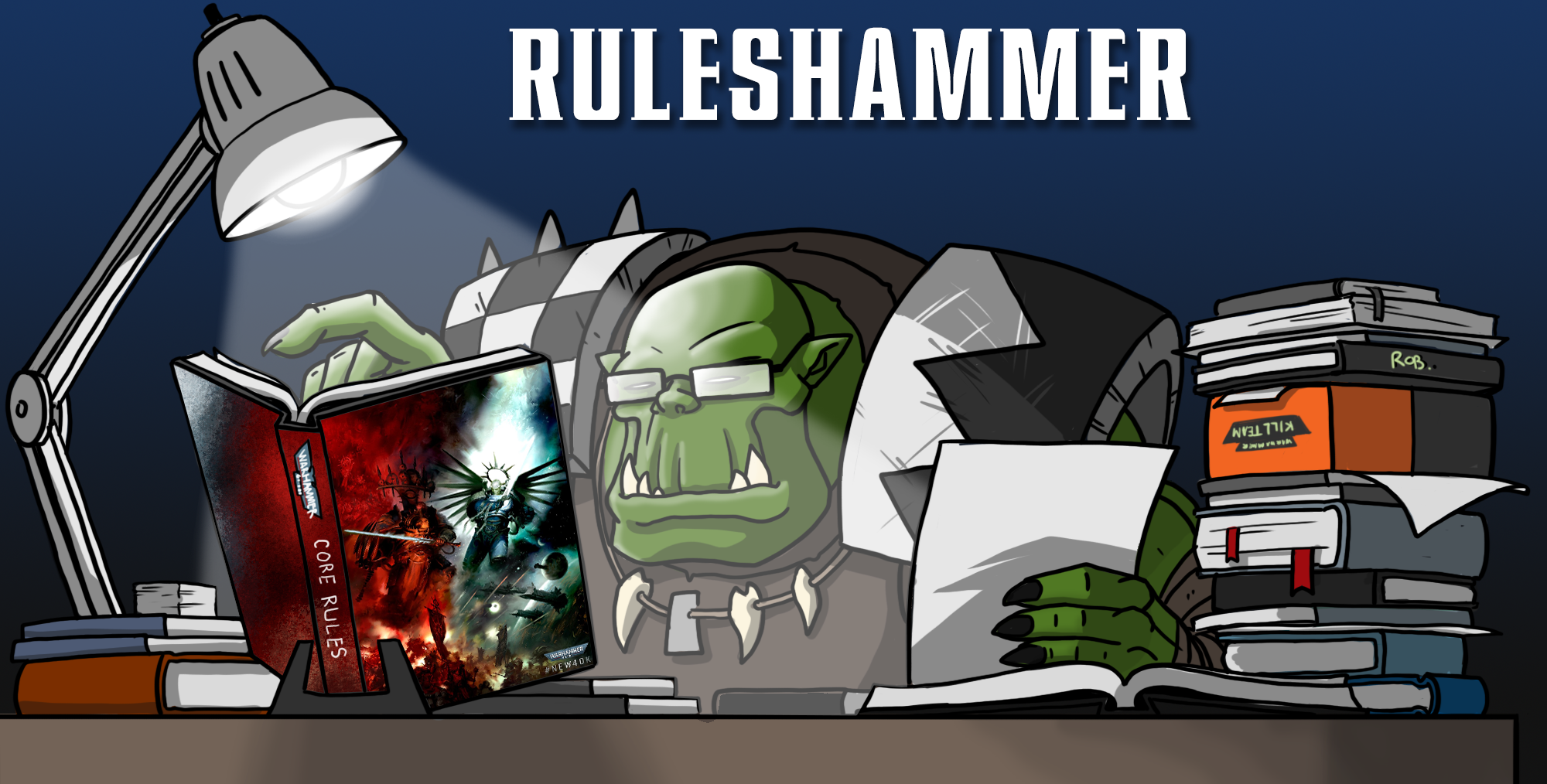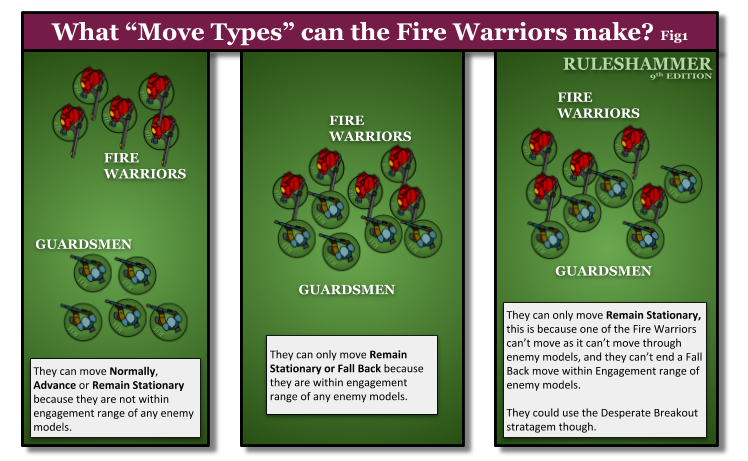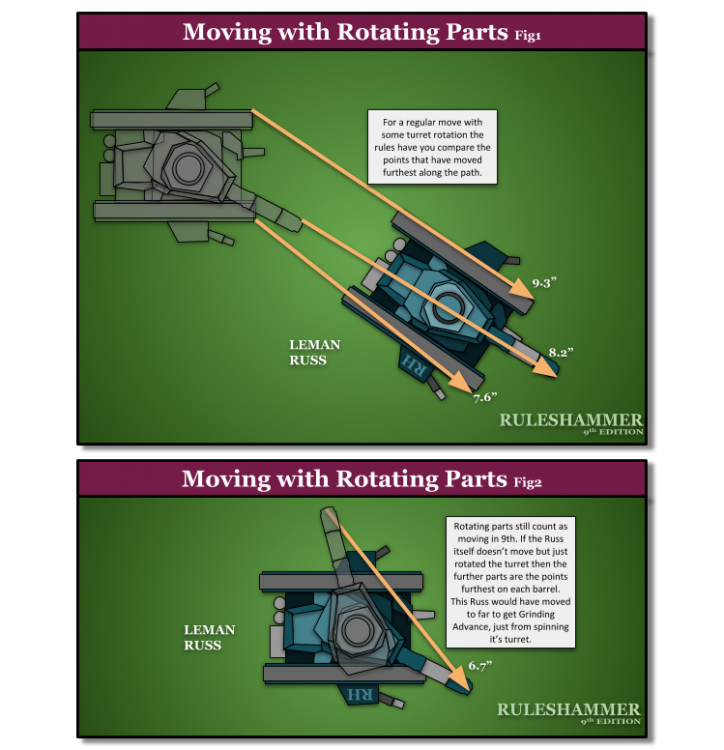Table of Contents
Types of Move – Movement Phase
These are the types of move for the Movement Phase, there are more in the Charge Phase and Fight Phase.
General Movement Rules
These rules set out the basics of movement, including which type of movement are allowed and when.
What type of move can my models make?
Start your Movement phase by selecting one unit from your army to move; that unit can either make a Normal Move, it can Advance, or it can Remain Stationary (see right). If a unit is within Engagement Range (pg 4) of any enemy models when it is selected to move, it cannot make a Normal Move or Advance; it can either Remain Stationary or it can Fall Back (see right). After you have finished moving that unit, you can then select another unit from your army to move in the same manner, and so on, until you have done so with as many of your units as you wish.
“Where to Measure From” and Rotation
When you move a unit, you can move any of its models (you can also choose not to move some of the models in that unit if you wish). Whenever you move a model, you can pivot it and/or change its position on the battlefield along any path, but no part of the model’s base (or hull) can be moved across the bases (or hulls) of other models, nor can any part of that model (including its base) cross the edge of the battlefield. You can also rotate any movable part of the model (such as turrets and sponsons) when it is moved. The distance a model moves is measured using the part of the model’s base (or hull) that moves furthest along its path (including parts that rotate or pivot).
Moving With Rotating Parts
Some models have parts that can rotate independently of the main model, things like sponsons or turrets. Rotating these parts still counts as moving. The rules for 9th edition establish that no part of the model can move more than the max, and it’s best to do this by measuring the distance from where a point on the model began to where it finished.
See Known Issues below regarding some ambiguity about these rules.
When is moving Impossible?
Remember that a unit must finish any type of move in unit coherency (pg 4). If this is impossible, then that move cannot be made. No unit can be selected to move more than once in each Movement phase. Once you have moved all your units that you wish to, progress to the Reinforcements step of the Movement phase.
If you can’t end the move in coherency then you can’t move. There are other situations that prevent movement, such as certain terrain types and being surrounded by the enemy as show above can stop units in their tracks.
Types Of Move
Normal Move
When a unit makes a Normal Move, each model in that unit can move a distance in inches equal to or less than the Move (M) characteristic shown on its datasheet, but no model can be moved within Engagement Range of enemy models (pg 4). [Core Pdf Page10]
What does a normal move look like on the board?
Most Normal moves will be pretty straightforward. One thing to keep in mind with movement is that Engagement Range has both horizontal and vertical components. That mean’s it’s possible for a unit to block movement below them like this.
Advance
When a unit makes an Advance, make an Advance roll for the unit by rolling one D6. Add the result in inches to the Move (M) characteristic of each model in that unit until the end of the current phase. Each model in that unit can then move a distance in inches equal to or less than this total, but no model can be moved within Engagement Range of enemy models. A unit cannot shoot or declare a charge in the same turn that it made an Advance.
How does Advancing Work?
Advancing add to the maximum move a model can make. If a model has a move characteristic of 6″ then advancing can increase that, usually by D6″ (some abilities allow it to be increased more and some increase it by a set amount every time). What it doesn’t do is force a model to move that far or mean it has to move more than it’s base stat. If a model has a 6″ move and rolls a 3 on it’s advance dice roll it now has a max move of 9″. It could decide to move anything between 0″ to 9″, but at this point even if it moves 0″ it would still count as having advanced. As as such only be able to shoot with assault weapons.
Fall Back
When a unit Falls Back, each model in that unit can move a distance in inches equal to or less than the Move (M) characteristic shown on its datasheet, and when doing so you can move it within Engagement Range of enemy models, but it cannot end its move within Engagement Range of any enemy models – if it cannot do this then it cannot Fall Back. A unit cannot declare a charge in the same turn that it Fell Back. A unit cannot shoot or attempt to manifest a psychic power in the same turn that it Fell Back unless it is Titanic.
How does Falling Back work?
There’s mostly just clarifications for the Fall Back move, like all moves you still can’t move through enemy models but you can now explicitly move within Engagement range of enemy models. If it’s not possible to end the fall back move with none of your models within Engagement Range of enemy models than the unit can’t fall back at all. It’s this situation that the new Desperate Breakout stratagem is for.
Titanic and Falling Back
Titanic models can shoot after falling back (even if they have no specific ability for it on their datasheet). Also bear in mind that the majority of Titanic Models (if not all of them) are Vehicles or Monsters, so in some rare occasions you might want to remain in combat and shoot, but the models would have -1 to hit for their heavy weapons and would be unable to target BLAST weapons at the unit they are in combat with. It’s really only useful in situations where keeping the unit from firing itself is better than full damage output for your model..
Psychic and Falling Back
Psykers that Fall Back can’t use their powers now unless they are Titanic. They can however use them whilst locked in combat, so there’s some decisions to be made on what you need most. To be able to shoot at that unit with them, or to cast powers on something else.
What does FLY do?
If a unit’s datasheet has the Fly keyword, then when it makes a Normal Move, an Advance or it Falls Back, its models can be moved across other models (and their bases) as if they were not there, and they can be moved within Engagement Range of enemy models. In addition, any vertical distance up and/or down that they make as part of that move is ignored. However, these models cannot finish their move either on top of another model (or its base) or within Engagement Range of any enemy models.
FLY is pretty clear. Ignore the vertical distance needed to clear terrain and move through enemy models and Engagement range but not end within it. One thing to keep in mind though is that not all FLY models are INFANTRY, BEAST or SWARM and moving through walls and floors for the Breachable and Scaleable terrain traits respectively requires one of those keywords to allow movement through them. If a FLY model starts a move inside a terrain piece without one of them it does not get to entirely ignore the terrain.
 Update: At time of publication Crisis Suits did not have the infantry keyword, they do now have that Keyword and can make use of the Breachable and Scaleable rules. Despite the depicted model no longer being an example the diagram is still accurate for models such as Jetbikes, Vipers, Tau Piranhas, etc.
Update: At time of publication Crisis Suits did not have the infantry keyword, they do now have that Keyword and can make use of the Breachable and Scaleable rules. Despite the depicted model no longer being an example the diagram is still accurate for models such as Jetbikes, Vipers, Tau Piranhas, etc.
Remain Stationary
If a unit Remains Stationary, none of its models can be moved for the rest of the phase. Any units from your army that were on the battlefield and were not selected to move in the Move Units step of the Movement phase are assumed to have Remained Stationary that phase.
What does Remain Stationary mean for other parts of the game?
So even before you get to the Reinforcements rules this explains clearly that if models weren’t on the battlefield at the start of the turn, then they did not Remain Stationary. It also means now that rules that say a model or unit should be treated as if it remained stationary (or that it did not move for some abilities with older wording) means the unit should NOT be treated as if it Advanced or Fell Back as Remain Stationary is exclusively for when a model has not done a normal, advance or fall back moved. There are occasions and abilities where models may have done one or more of the other move types in a single turn.
Known Issues
Falling back and “as if it hadn’t moved” abilities
Currently this could really go either way. Current the Ruleshammer opinion is that treating a model as if hadn’t moved this turn would mean treating it as if hadn’t fallen back either as that is a type of move. However the glossary section for 9th clearly defines the conditions for having Fallen Back and could arguably imply that it’s a flag that remains regardless of “as if it hadn’t moved abilities”. Hopefully there’s an FAQ on this soon.
Rotating Parts – Distance vs Displacement
There’s arugable ambiguiity in the movement rules about exactly how to account for the movement of rotating parts. My thought process really is that it’s not specific enough to argue it’s 100% either way.
The distance a model moves is measured using the part of the model’s base (or hull) that moves furthest along its path (including parts that rotate or pivot).
This is all we have, and my view is that models move along a path, and legal paths are ones where no point on the model is further where along the path from where it started than the max movement. The majority of paths are straight lines. Sometimes you might have to do two half-paths added together for each point if the model has to go around a terrain piece. This fits in with all the other measurements in the game which are geneally also point to point. In my diagram for the rotating turret my position is that the path of the model is a dot, but tip of that barrel is 6.7″ from where it began.
Turrets were a mess in 8th, basically not existing in the rules at all. In 9th they suddenly count but there’s not really enough explanation for the how, personally I’d have preferred all turrets to have to remain as they were when deployed.
Games Workshop FAQ
None
Ruleshammer Q&A
Regarding the Falling Back move type and a Tau Maneuvering Thrusters
With the new movement rules in 9th edition regarding a unit being classified as “remain stationary”, “normal move”, “advance”, or “fall back” how does that interact with the Tau custom tenet, “Manoeuvring Thrusters” which allow a BATTLESUIT unit to advance when it falls back. Would this allow BATTLESUITs to fallback and shoot as if they advanced? – Danny
First let’s look at the text for that Sept Ability, from Page 35 of The Greater Good.
A BATTLESUIT unit with this tenet can Advance when it Falls Back.
The short answer to this question is pretty bluntly no. The ability doesn’t allow a model to ignore that it fell back for shooting purposes, it doesn’t not say the model can shoot as if it hadn’t moved, or as if it was stationary this turn. Essentially this causes a situation where the model has actually both Advanced and Fallen Back. It would have the limits and restrictions of both those rules, so despite the Assault weapons rules allowing you to fire them even units have Advanced those rules do not allow for a unit to shoot if it fell back.







You must be logged in to post a comment.